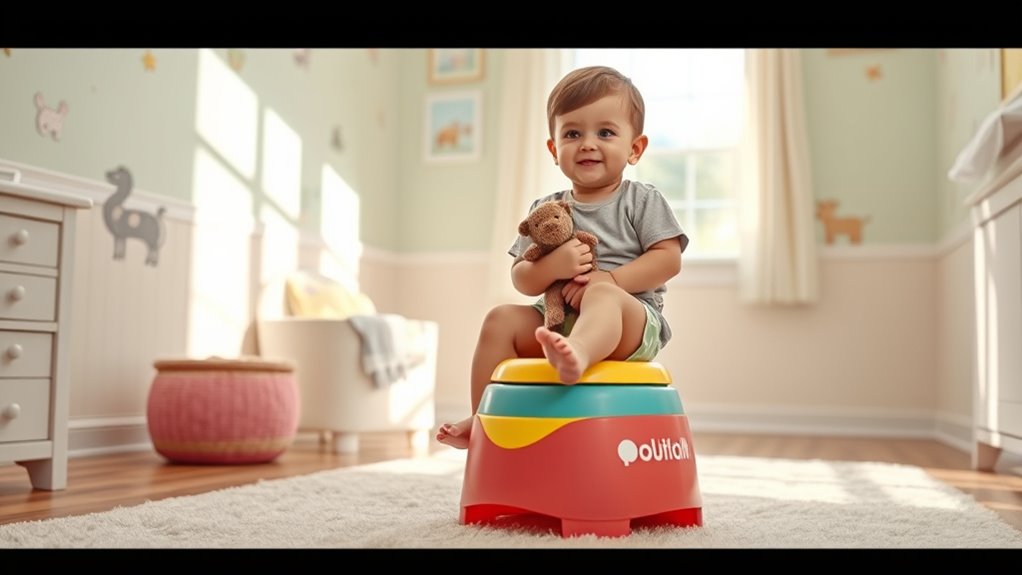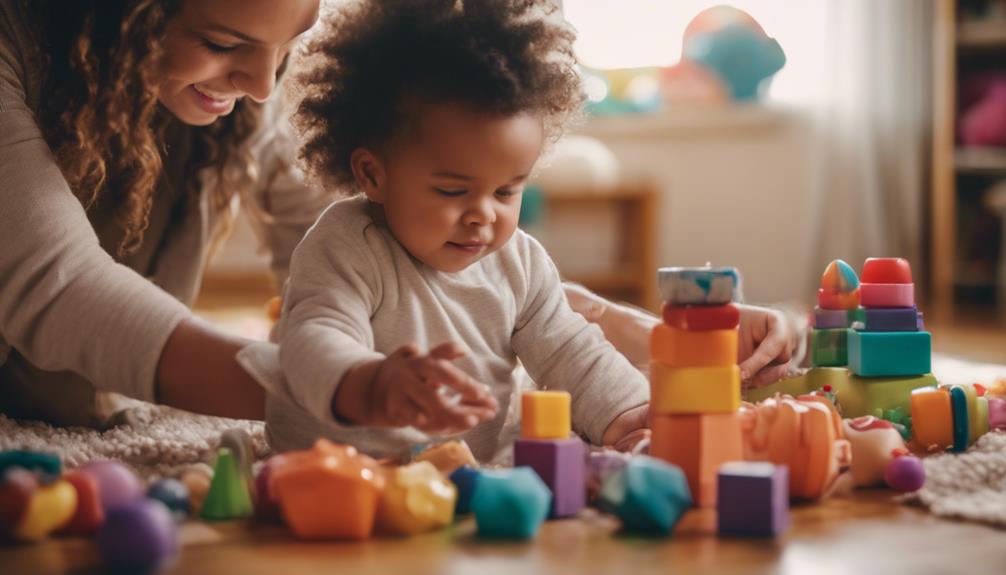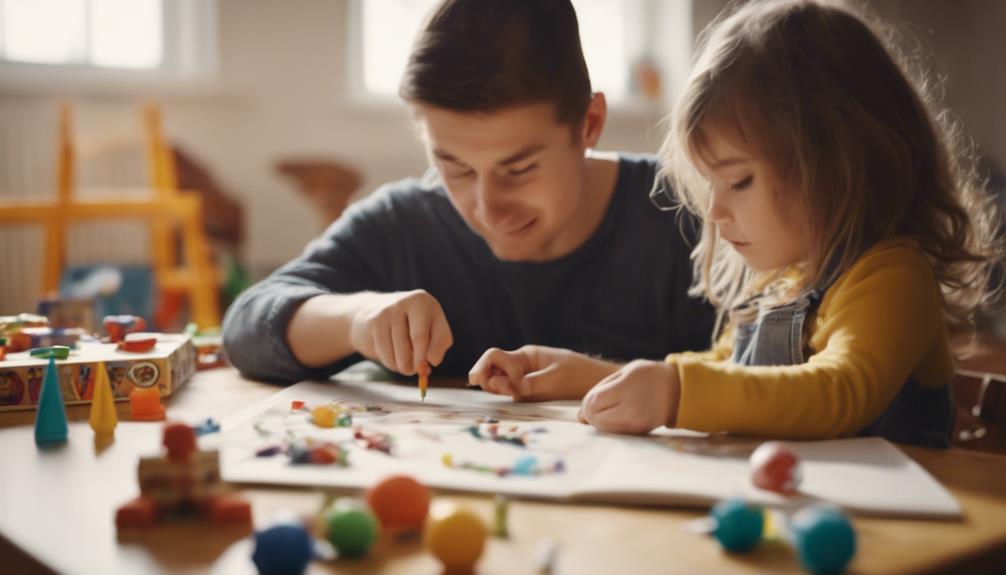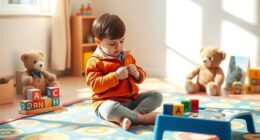To gauge your child’s readiness for potty training, look for signs like staying dry longer, showing interest in the bathroom, and communicating needs. Prepare a welcoming bathroom space with a child-sized potty and easy-to-reach supplies. Use positive reinforcement, patience, and consistent routines to encourage progress. Expect setbacks and handle accidents calmly to build confidence. By understanding these key tips and signs, you’ll set the stage for a successful potty training journey—learn more to make it smoother.
Key Takeaways
- Recognize signs of readiness such as staying dry longer, showing interest in bathroom routines, and communicating needs clearly.
- Create a comfortable, accessible bathroom environment with child-sized equipment and safety features.
- Use positive reinforcement, patience, and consistent routines to motivate and support your child’s progress.
- Handle setbacks calmly, offering reassurance and maintaining routines to rebuild confidence.
- Celebrate small successes and avoid pressure to foster independence and intrinsic motivation.
Recognizing the Signs of Readiness in Your Child

Knowing when your child is ready for potty training is key to a smoother experience. Pay attention during diaper changes—if your child stays dry for longer periods or shows discomfort with a wet diaper, it’s a good sign they’re ready. Watch for toddler tantrums that occur when you try to put on or remove their diaper; this indicates they’re becoming aware of their body and preferences. Additionally, if your little one starts to show interest in the bathroom, mimics your actions, or asks to use the toilet, these are strong signals. Consistent diaper changes and noticing their reactions help you gauge their readiness. Being attentive to these signs ensures you don’t rush and set your child up for success in potty training. Understanding developmental milestones can further help you determine if your child is physically and emotionally prepared for this step. Recognizing signs of physical and emotional readiness helps create a positive potty training experience, especially as these indicators often align with benefits of proper timing, revealing underlying behavioral shifts. Paying close attention to child’s behavior provides additional insight into their overall development and readiness.
Preparing Your Child for Potty Training
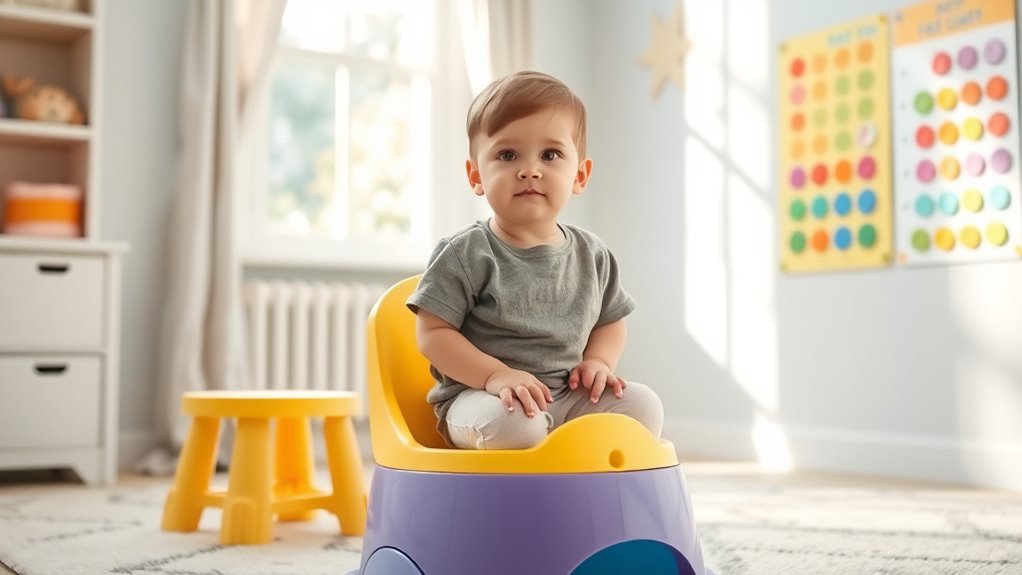
To prepare your child for potty training, start by recognizing the signs they’re ready, like showing interest or staying dry longer. Next, set up a comfortable, accessible bathroom space to make the process easier. These steps help create a positive environment that encourages your child’s independence. Incorporating potty training tips and using supportive tools can further facilitate a smoother transition. Additionally, understanding training readiness cues can help you time the process more effectively.
Recognizing Readiness Signs
Before starting potty training, it’s important to observe your child’s behavior for signs of readiness. Recognizing these signs helps you avoid common potty training myths and respect cultural differences that influence when children are ready. Look for signs like staying dry for longer periods, showing interest in the bathroom, or discomfort with dirty diapers. Your child may also try to communicate needs or imitate adults using the toilet. Keep in mind, every child develops at their own pace, so don’t rush based on age alone. Watch for these cues to determine if your child is prepared to begin. Being attentive ensures a smoother process and helps you both feel confident moving forward. Additionally, understanding child development milestones can provide insight into optimal timing for starting potty training. Recognizing signs of readiness can also help you tailor your approach to your child’s unique development. Observing their ability to follow simple instructions and manage their clothing can further indicate potty training readiness. Recognizing developmental cues is essential for aligning your efforts with your child’s individual growth pattern.
Setting Up the Bathroom
Preparing your bathroom environment is a vital step in successful potty training. Start by adding essential toilet accessories like a child-sized potty seat or a step stool to help your child feel secure. Keep a small shelf nearby with easy-to-reach toilet paper and wipes to encourage independence. Guarantee bathroom safety by securing any loose rugs, installing safety locks if needed, and keeping cleaning supplies out of reach. Consider using a non-slip mat inside and outside the potty to prevent slips. Clear clutter and create a calm, inviting space that makes your child feel comfortable and confident. Properly setting up the bathroom minimizes accidents and builds your child’s confidence, making the transition smoother and more positive. Additionally, organizing the bathroom with vertical storage solutions can help maximize space and keep essentials accessible. Incorporating child-friendly designs can further make the environment more welcoming for your little one. Being aware of practical support options can help caregivers manage any challenges that arise during potty training, ensuring a more successful process. Utilizing innovative bathroom accessories designed for young children can also enhance the training experience and foster independence. As market volatility impacts investments, including a Gold IRA can provide additional security and diversification for your child’s financial future.
Choosing the Right Equipment and Environment
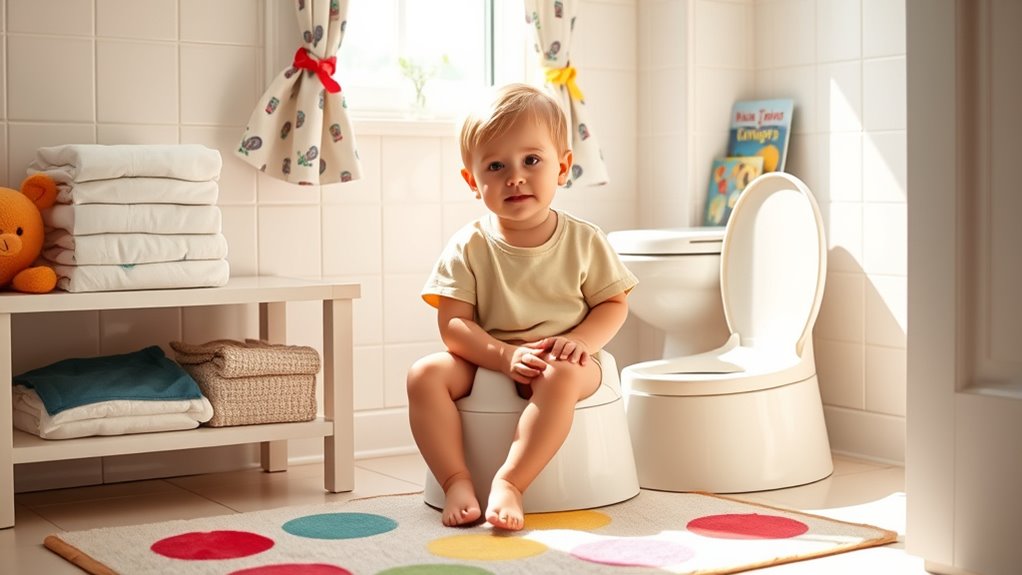
Choosing the right equipment and environment is essential for making potty training successful and comfortable for your child. Selecting a suitable potty seat, such as a child-sized seat or a seat reducer, helps your child feel secure and confident. Make certain your bathroom has essential safety features like non-slip rugs, child-proof locks, and easily accessible supplies. A well-organized space encourages independence and reduces accidents. Here are key points to contemplate:
- Opt for a potty seat with stable, non-slip grips
- Prioritize bathroom safety features to prevent falls
- Keep supplies within easy reach for independence
- Use a step stool to help your child reach the toilet comfortably
- Maintain a clean, clutter-free environment for comfort and safety
- Incorporating bathroom safety features can further enhance safety and peace of mind. Proper venting and adequate clearances from combustibles are also important considerations to ensure a safe and effective setup.
- Ensuring proper ventilation helps reduce odors and maintain a fresh environment, contributing to a more pleasant potty training experience. Additionally, selecting appropriate bathroom equipment can support your child’s comfort and confidence during training.
- Paying attention to child comfort and ergonomic design can make the potty training process more positive and less stressful for your child.
Effective Strategies to Encourage Success
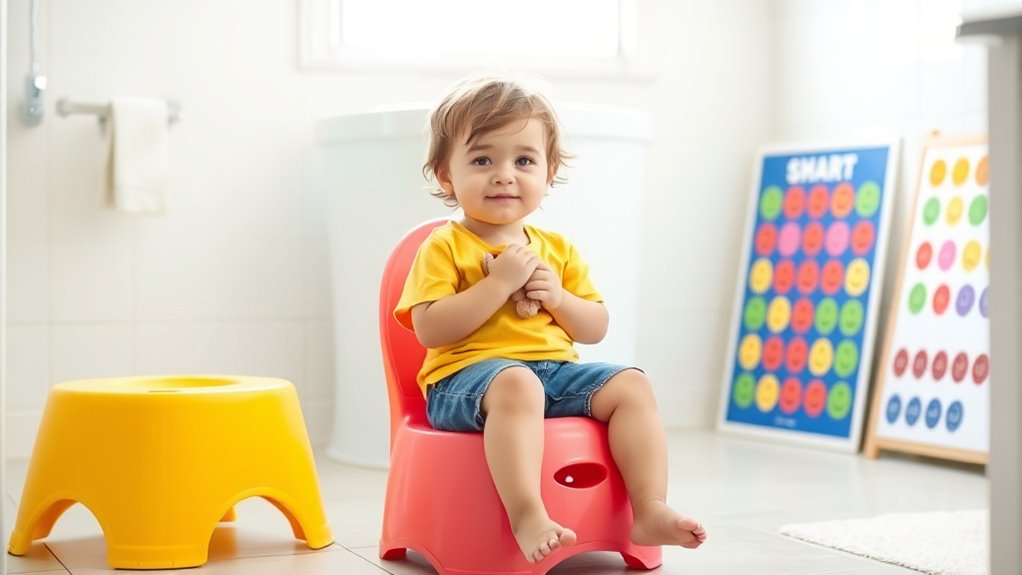
Once your child’s potty environment is set up comfortably and safely, encouraging consistent success becomes the next step. Offering diaper alternatives, like training pants or pull-ups, can help your child feel more independent while still providing some protection. Reinforce positive behaviors with praise and patience, making each success a milestone. Reading potty training books together can also boost motivation, as stories often normalize the process and reduce anxiety. Keep routines predictable, and let your child choose their potty or training seat to foster ownership. Consistency is key—celebrate small victories and stay patient through setbacks. By creating a positive, encouraging atmosphere and using helpful tools like diaper alternatives and engaging books, you’ll set the stage for steady progress and confidence. Incorporating pediatric sleep specialists or other experts can provide additional tailored guidance to support your child’s development.
Handling Common Challenges and Setbacks
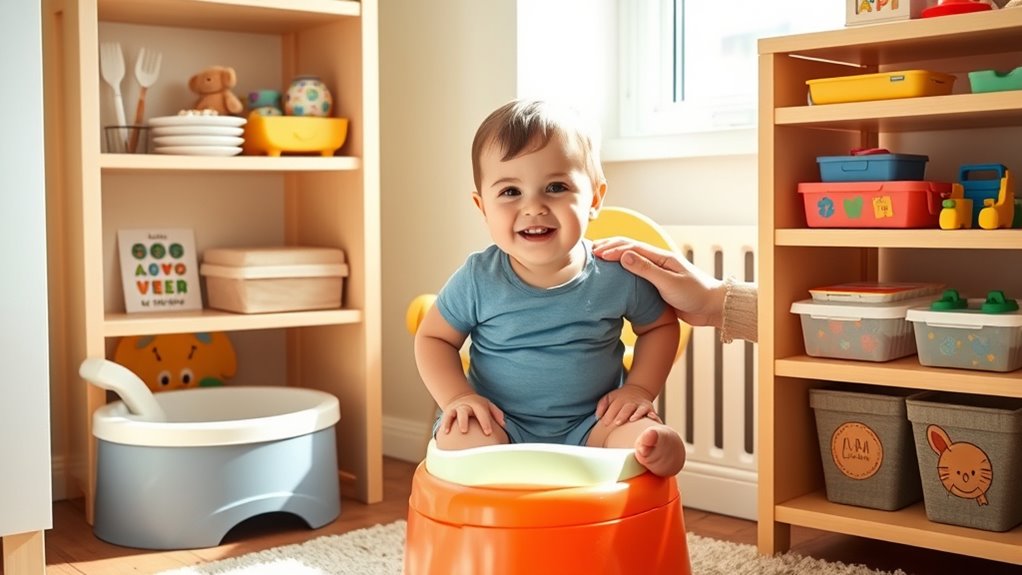
Challenges like regression, accidents, and loss of motivation can happen during potty training. When they do, stay calm and support your child without frustration. Addressing these setbacks with patience helps keep progress steady and confidence high.
Addressing Regression Issues
Regressions during potty training are common and can be frustrating, but understanding why they happen helps you handle setbacks calmly. Often, regressions stem from emotional regulation challenges or peer influence, making your child feel overwhelmed or unsure. Recognizing these triggers helps you support their progress without pressure. Keep in mind:
- Regressions are temporary and normal in development
- Emotional regulation plays a key role in setbacks
- Peer influence can cause children to revert
- Patience and reassurance help rebuild confidence
- Consistent routines provide stability during setbacks
Managing Accidents Calmly
Accidents are an inevitable part of potty training, and handling them calmly helps your child stay confident and motivated. Many potty training myths suggest that accidents mean failure, but they’re simply part of the learning process. When accidents happen, resist the urge to react with frustration or punishment. Instead, reassure your child that it’s okay and remind them that everyone makes mistakes while learning new skills. Managing accidents with patience reduces parent anxiety and models calm, positive behavior. Remember, setbacks don’t define progress; they’re opportunities to encourage your child gently. By staying composed and supportive, you help your child develop a healthy attitude toward potty training, making the experience less stressful and more successful for both of you.
Sustaining Motivation Over Time
As your child progresses through potty training, it’s normal to encounter setbacks and moments when motivation wanes. To keep them engaged, use reward systems that celebrate small successes, making the process positive and encouraging. Remember, peer influence can motivate your child—seeing friends or siblings using the potty can boost their enthusiasm. To sustain motivation, consider these tips:
- Consistently praise progress, not perfection
- Incorporate fun, age-appropriate rewards
- Avoid punishment for accidents
- Set achievable goals with your child
- Surround them with positive peer examples
Reinforcing Positive Habits and Building Confidence
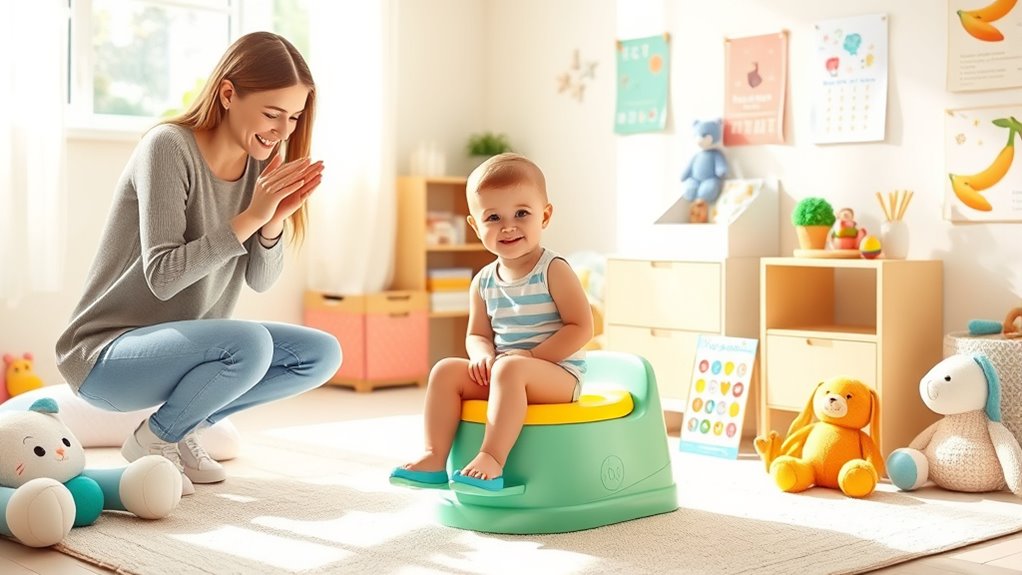
Celebrating small successes and consistently offering praise helps your child build confidence and develop positive habits. Use reward systems like stickers or extra playtime to motivate them, making potty training a positive experience. Praise techniques such as specific compliments—“Great job sitting on the potty”—encourage your child to repeat good behavior. Focus on immediate recognition to reinforce their efforts. Avoid over-praising or using food as a reward, which can undermine intrinsic motivation. Instead, highlight their progress and effort, helping them feel proud and capable. By reinforcing positive habits with consistent praise and suitable reward systems, you foster a sense of achievement. This approach boosts your child’s confidence, making them more enthusiastic to master new skills and develop independence in potty training.
Frequently Asked Questions
How Long Does the Typical Potty Training Process Take?
The typical training timeline varies, but potty training duration usually spans several weeks to a few months. You might see your child start showing progress within a few days, yet full mastery can take longer. Remember, each child’s pace differs, so avoid rushing. Stay patient and consistent, and you’ll help your little one develop independence confidently. The journey’s length depends on your child’s readiness and your consistent support.
Are There Specific Signs That Indicate My Child Is Not Ready?
Think of your child’s readiness as a garden waiting to bloom. If you notice signs of resistance, like refusal cues or persistent fussiness during potty attempts, it’s a signal that the soil might not be ready yet. These refusal cues act like weeds, indicating they’re not prepared for this step. Pushing through may hinder growth, so watch for these signs and wait until your child’s cues show genuine interest and cooperation.
Should I Start Potty Training During a Particular Season or Time of Year?
You might wonder if seasonal timing affects potty training. While there’s no perfect season, many find spring or summer ideal because the weather is warm and predictable. This makes it easier for your child to stay dry and practice without heavy clothing. Weather considerations like avoiding cold or rainy days can help, so choose a time when your child’s routine is stable and the climate supports outdoor practice and quick clothing changes.
How Can I Involve Siblings or Other Family Members in the Process?
Did you know that children with involved family support potty train up to 30% faster? To include siblings or other family members, encourage them to cheer on your child and participate in practice routines. Family involvement boosts motivation and creates a positive environment. Siblings can model proper technique, and everyone’s encouragement helps your child feel supported and confident, making the process smoother and more fun for the whole family.
What Are the Best Ways to Handle Nighttime Potty Training?
When handling nighttime potty training, focus on establishing consistent sleep routines and encouraging nighttime dryness. Limit drinks before bed and use waterproof mattress protectors to ease concerns. Gently wake your child to use the bathroom if needed, but avoid making it a stressful experience. Celebrate small successes to boost confidence, and remember that nighttime dryness may take longer, so be patient and supportive throughout the process.
Conclusion
Now that you’re armed with all the potty training secrets, remember: patience is your secret weapon—because nothing says “success” like a tiny throne and a bathroom full of laundry. Embrace the mess, celebrate small wins, and keep your sense of humor intact. After all, mastering the art of potty training isn’t just about your kid—it’s about transforming you into a bathroom ninja. Good luck, brave parent—your porcelain kingdom awaits!

